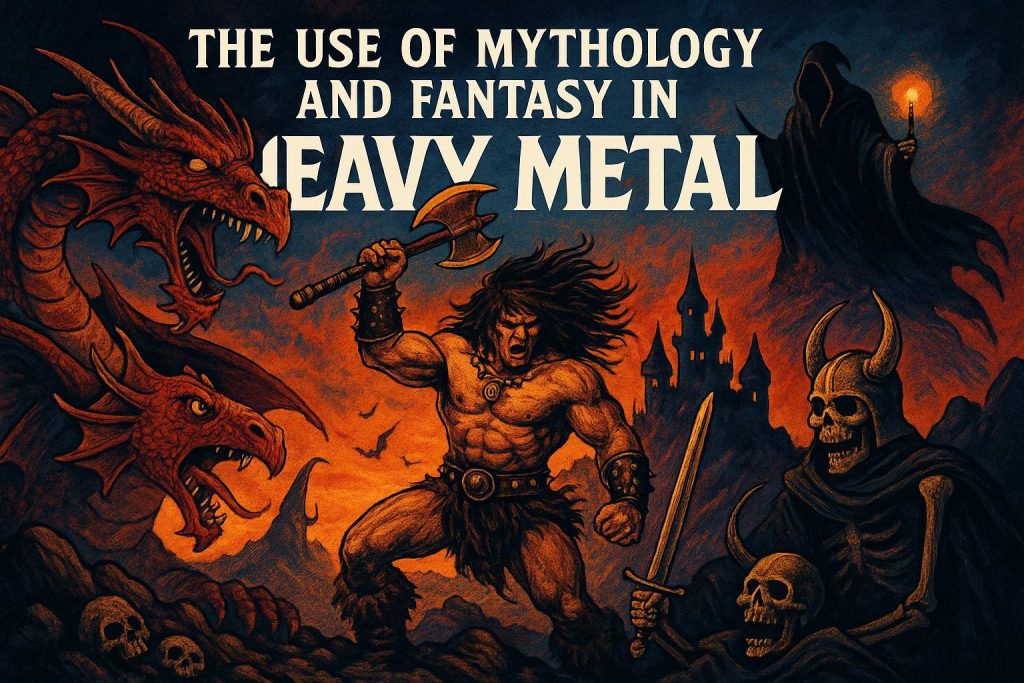The Use of Mythology and Fantasy in Heavy Metal

Introduction to Mythology and Fantasy in Heavy Metal
Heavy metal music, renowned for its powerful sound characterized by amplified distortions and vigorous drumming, often finds its thematic foundation in the realms of mythology and fantasy. These elements not only provide depth to lyrical content but also serve as integral sources of storytelling that delve into universal themes of heroism, colossal battles, and the nature of the supernatural. Over the decades, numerous metal bands have meticulously crafted intricate narratives and vivid images inspired by ancient and fantastical tales within their songs, creating a rich and detailed tapestry that has become one of the defining features of the genre.
Mythological Themes in Heavy Metal
Mythology offers a vast and varied repository of stories, characters, and symbols, which align seamlessly with the dramatic essence of heavy metal. Renowned for its ability to evoke grandeur and existential reflection, the genre often incorporates elements from various mythologies, spanning Greek, Norse, Egyptian, and even Celtic traditions. These ancient stories introduce archetypal heroes, formidable deities, and moral tales that still resonate with contemporary audiences. For instance, Iron Maiden, a band synonymous with heavy metal, frequently interweaves their music with references to historic and mythological figures. Their ability to craft songs imbued with a sense of epic adventure underscores the timeless appeal of mythological narratives.
Similarly, Ensiferum, a Finnish band, draws deeply from Norse mythology. The lyrics and overarching themes in their music are steeped in Viking legends and epics, presenting tales of valor and conquest. By harnessing the raw and evocative power of myth, bands cast listeners into worlds where tales of ancient gods and heroes become alive, serving as allegories for human endeavors and struggles.
Moreover, the mythological themes in heavy metal often also serve as allegories for modern existence. These tales offer artists a means to explore societal critiques or philosophical discourses within the guise of epic storytelling. The reinterpretation of mythological narratives within a modern context allows the audience to engage with age-old stories, reimagined to resonate with contemporary concerns and complexities.
Fantasy Elements in Heavy Metal
Parallel to mythology, fantasy as a genre provides a fertile ground for the creation and development of vivid musical narratives. Fantasy themes within heavy metal are not merely adjunct but often interlace seamlessly with mythological motifs, offering a multidimensional auditory experience replete with landscapes filled with fantasy worlds and medieval backdrops. These are often populated with magical beings, heroes, and creatures, stoking the imaginations of listeners.
Bands like Blind Guardian have taken this integration a step further by crafting entire albums inspired by the legendary works of J.R.R. Tolkien and other iconic fantasy authors. Their music brings the rich tapestry of Middle-earth to life, capturing its diverse races, majestic landscapes, and epic tales of struggle and triumph in a sonorous form. Such elements allow musicians to create rich, immersive musical experiences that blend the lines between story and song, making each track feel like a miniature narrative encapsulation.
The engagement with fantasy also allows heavy metal bands to explore themes of heroism, conflict, and destiny within constructed realities free from the constraints of the physical world. This creative freedom offers bands the latitude to pursue complex storytelling and create expansive narrative arcs across albums, deepening the connection with their audiences who embark on these fantastical journeys with them.
The Role of Album Art and Stage Performances
Apart from the lyrical and musical content, heavy metal bands adopt mythology and fantasy motifs through album artwork and stage performances. The visualization of mythical and fantastical scenes through album covers often extends the thematic content of music beyond auditory confines, serving as a prelude to the epic tales within. Artists meticulously craft these images to evoke the grandeur of the stories, augmenting the auditory experience with visual metaphors and symbolism.
Elaborate stage setups and vibrant costumes further enhance these themes, transforming live concerts into dramatic reenactments of fantastical or mythical events. Such performances transcend mere musical engagement, becoming larger-than-life spectacles that draw audiences into an interactive experience. The theatrical nature of these performances, underscored by dramatic orchestration, lighting, and effects, enables fans to immerse themselves in these otherworldly realms, making concerts unforgettable spectacles that encapsulate the spirit of mythology and fantasy in heavy metal.
Furthermore, these visual and performative elements complement the ambitious narratives depicted through the music, blending audio and visual artistry into cohesive storytelling forms. This fusion provides fans with an avenue to not just listen to the music, but to see and experience the vivid stories as they unfold, enriching the overall impact.
Conclusion
The seamless integration of mythology and fantasy into heavy metal transcends simple thematic inspiration; it is pivotal to the genre’s core identity. By harnessing complex narratives and grandiose themes, heavy metal persists in captivating audiences with its distinctive amalgamation of potent soundscapes and immersive storytelling. This cultural and artistic synergy draws musicians and listeners alike into a timeless reverie, inviting them to traverse the mist-laden corridors of history and imaginative future realms alike. Through its marriage of sonic intensity and thematic depth, heavy metal continues to be a bastion of creative exploration, where stories, both old and new, come alive for successive generations of fans.